Just like waxing, sugaring removes unwanted body hair, but why pay extra when you can do both at a lower price? Regardless of popular belief, sugaring is not only a form of body hair removal, it is considered a form of art with sculpting, precision, and elegance attached to it.
Sugaring techniques can effectively be applied to legs, bikini lines, underarms, and even faces. Customers generally favor it because of its ability to target small areas efficiently.
But, before you dive into the process, you might wonder: how is sugaring done? Let’s hear from the experts!
What Is Sugaring?
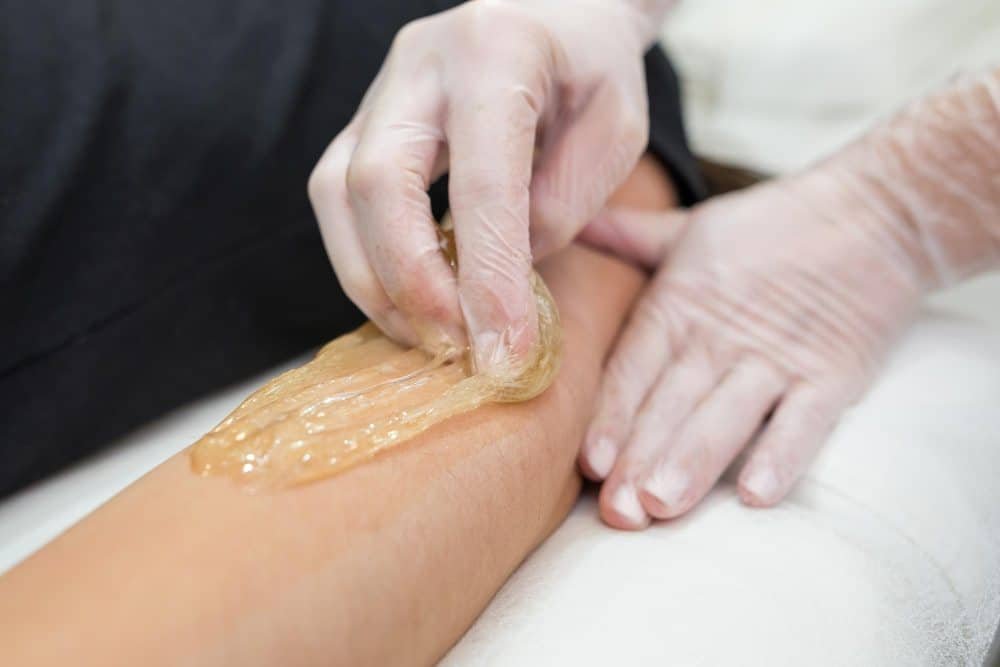
Sugaring is an age-old technique for hair removal. Specifically, it involves the use of a sugar, water, and lemon juice mixture to pull out hair strands. Sugaring has been in practice for centuries, particularly in ancient Egypt and Greece.
The process begins with putting a sticky paste on the skin. The paste then binds to the hair rather than the skin, and the paste is removed which in turn pulls the hair out. Many people opt for sugaring rather than waxing because it causes less pain, and it is less harsh on the skin compared to other methods making it an excellent natural alternative for achieving smooth skin.
All in all, sugaring is a more natural, less harsh, and faster approach to body sculpting when compared to waxing. This is one of the reasons why many people who wish to have smooth and healthy skin prefer it.
How Is Sugaring Done?
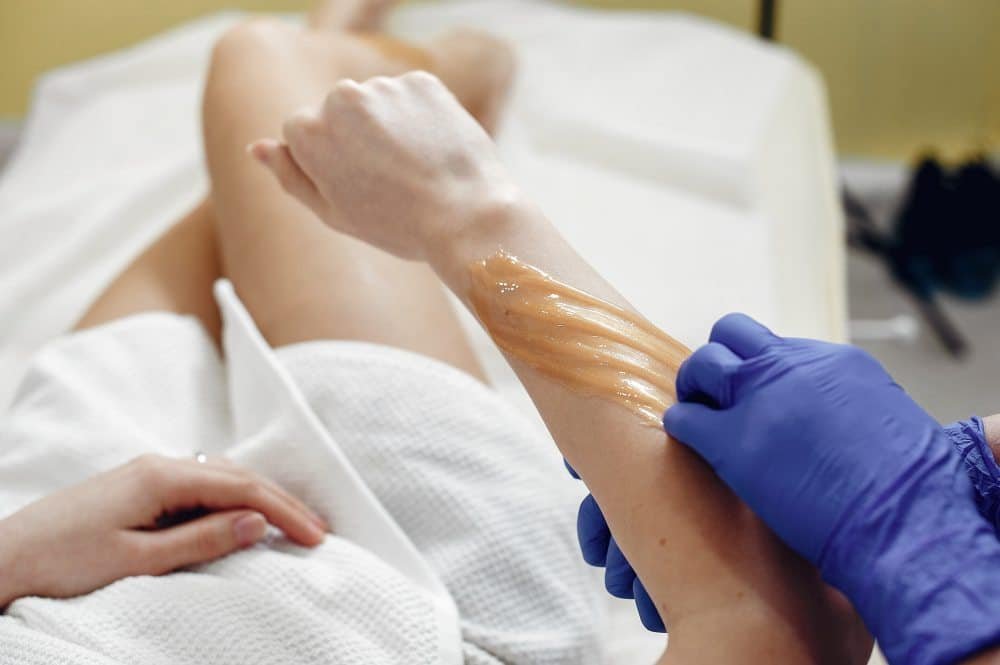
Sugaring is a method of hair removal whereby a sticky paste made of sugar, water, and lemon is used. It works in the same fashion as waxing where hair is required to be grown out for the paste to stick to it.
The sugar paste is worked into the follicle as it is applied in the opposite direction of hair growth. The flicking motion used to take off the paste allows for the hair to be pulled out in its natural direction of growth and is therefore regarded as smoother and less painful than waxing.
Sugaring removes hair by way of a ball of caramel-like sugar paste instead of strips of paper like waxing. The skin is prepared by gently rolling this paste over it while the direction of its application is opposite to that of hair growth.
The paste is then flicked off in the direction of hair growth allowing the hair to easily come off without breakage. This method greatly reduces discomfort, hair breakage, and even the chances of ingrown hair. In addition to removing hair, this technique also exfoliates the skin, leaving it soft and smooth.
Sugaring can not be used as a single form of hair removal and skin treatment. However, after frequent use, it can prove to be useful in slowing down the growth of unwanted hair.
Sugaring is not only effective and efficient, but it is also a safe and gentle way of getting smooth skin.
Which Areas Of The Body Can Be Sugared?
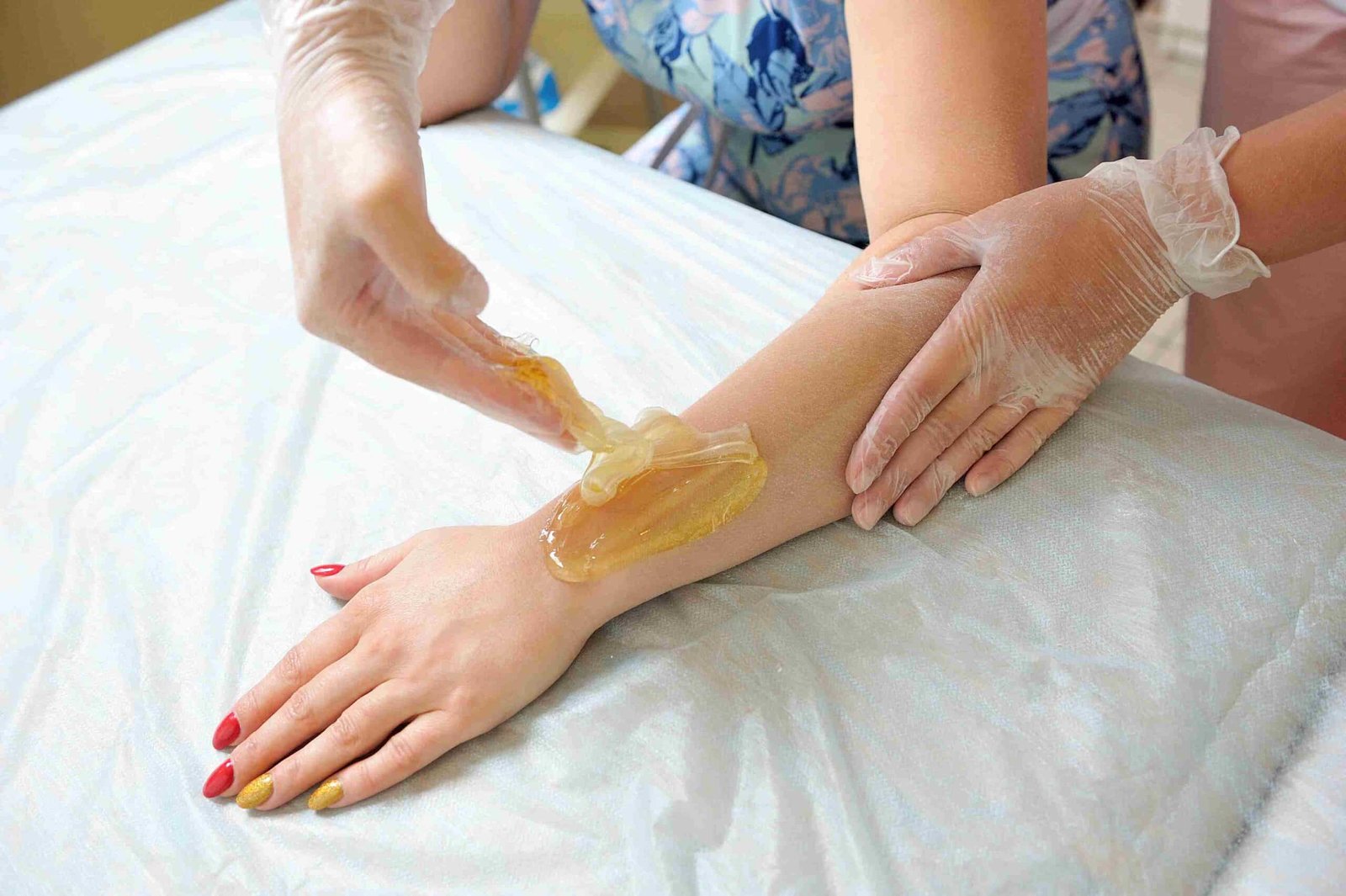
Sugaring is quite a flexible technique since it can be performed on almost all body parts.
From eyebrows to legs, arms to the bikini area, sugaring works wonders on a wide variety of spots. That is why this hair removal is convenient for people with sensitive skin as it enables them to achieve a consistently smooth and hairless appearance without irritation.
The most famous sugaring procedure type is the Brazilian bikini wax where all the bikini area hair is lasered off.
As people’s beauty standards rise, here are some of the most common areas that people choose to get sugared:
- Eyebrows: To achieve a beautiful shape.
- Upper lip: A clean facial look.
- Arms: Hairless, smooth skin.
- Legs: Smooth forearms from the knees to the ankles without hair.
- Back: For a clean back, suitable for men and women.
- Bikini area: Many people even get Brazilian wax for a clean look.
Sugaring is perfect for sensitive spots like lip or bikini lines because it’s much less abrasive than waxing. The sugar blend latches on only to the hairs and dead skin, so it’s not as aggravating.
In turn, that means less chances of skin reactions like reddening, bumps, or other forms of uneasiness. It is well-suited for these soft areas.
Sugaring, however, is not restricted to small surface areas. It is also useful for large surface areas of the body such as legs and back, since paste both goes on and comes off quickly, more areas can be treated in a shorter period. This makes it ideal for sugaring the entire body.
How Is Sugaring Different From Waxing?
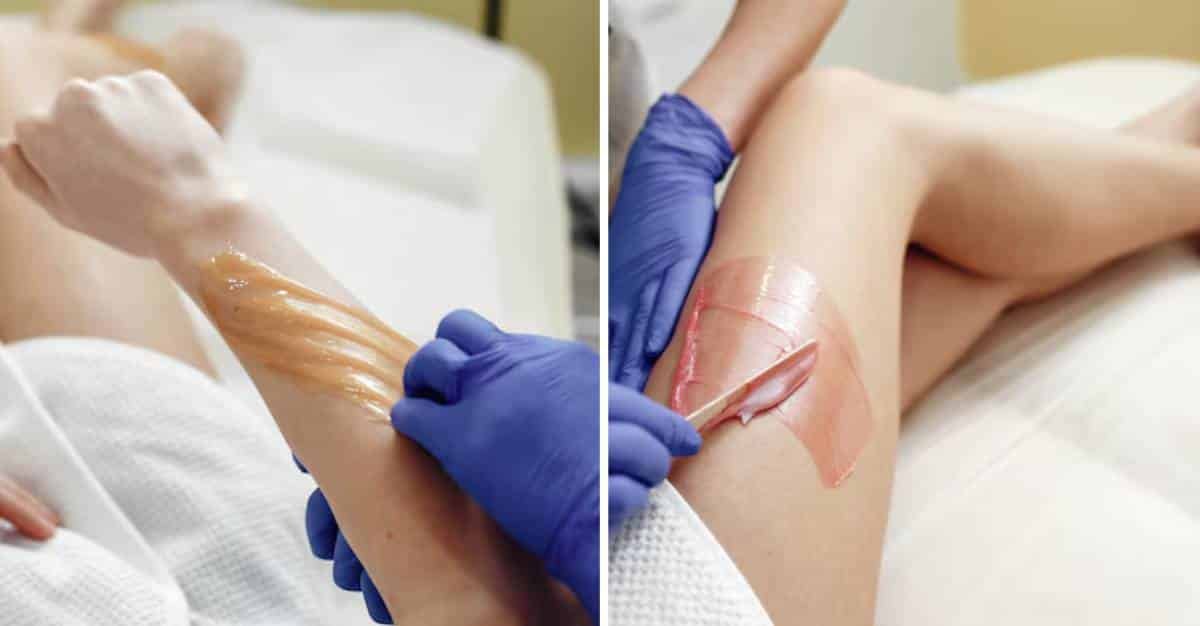
Both sugaring and waxing are well-known methods used for hair removal, yet, each of them tackles the issue differently. The main difference is how the hair is removed.
In waxing, the wax is applied first in the direction that the hair grows, and taken off in the opposite direction. This leads to hair follicle damage, which is then followed by skin irritation.
Sugaring, however, involves the opposite process, with the wax being first removed in the direction the hair grows, leading to reduced chances of broken hair follicles, and skin irritation.
Because waxing adheres to both hair and skin, when the wax itself is removed, some irritation occurs on the skin. This explains why many people suffer from skin redness, bumps, and bruises after waxing.
Sugaring, in contrast, only clings to hair and dead skin space. As it does not cling to live skin cells, it is a lot less aggressive and therefore is more suitable for people with sensitive skin. Additionally, the sugar paste is water-soluble, allowing for easy cleanup afterward without any sticky residues.
There is a difference in the treatment process as well. While waxing uses a swift action to pull the hair out, sugaring needs multiple tries to achieve the same effect.
This can also work positively as it allows one to have more control over the skin. Sugaring works more effectively in removing hair without hurting the skin, unlike waxing which can be very painful for some.
Waxing and sugaring can be done on arms, legs, back, underarms, the face, and bikini area. While some people claim sugaring is less painful than waxing in sensitive areas, it is largely dependent on the individual’s threshold.
Both techniques have their pros and cons but if your skin is sensitive then sugaring is an alternative one could try.
Is Sugaring Less Painful Than Waxing?
While waxing is more painful compared to sugaring, it’s important to understand that sugaring does not come without its own set of discomfort. Waxing and sugaring the area still results in pain because it is removed from the follicle.
Sugaring is still considered to be the more painless technique because the paste does not stick to the live skin. The adhesion of wax to the skin does exacerbate the pain felt during hair removal.
Most people agree that sugaring is less painful than waxing, especially for sensitive skin. Ultimately, there’s always an “ouch” factor in such procedures.
Sugaring can be less painful with repeated sessions because the rest of the procedure loosens the hair follicle. This means that, while it is incredibly beneficial in the long run, the client will still have to get through quite a bit of discomfort.
The hair needs to be a quarter of an inch at minimum for the procedure to work, but it’s important to note that the process is more painful if the hair is longer.
Pain during the sugaring procedure can be managed through skin preparation before the process. For instance, beginning from clean and dry skin these measures ensure that the sugar paste can adhere properly to the hair thus limiting pain.
How To Prepare For Sugaring Procedure?
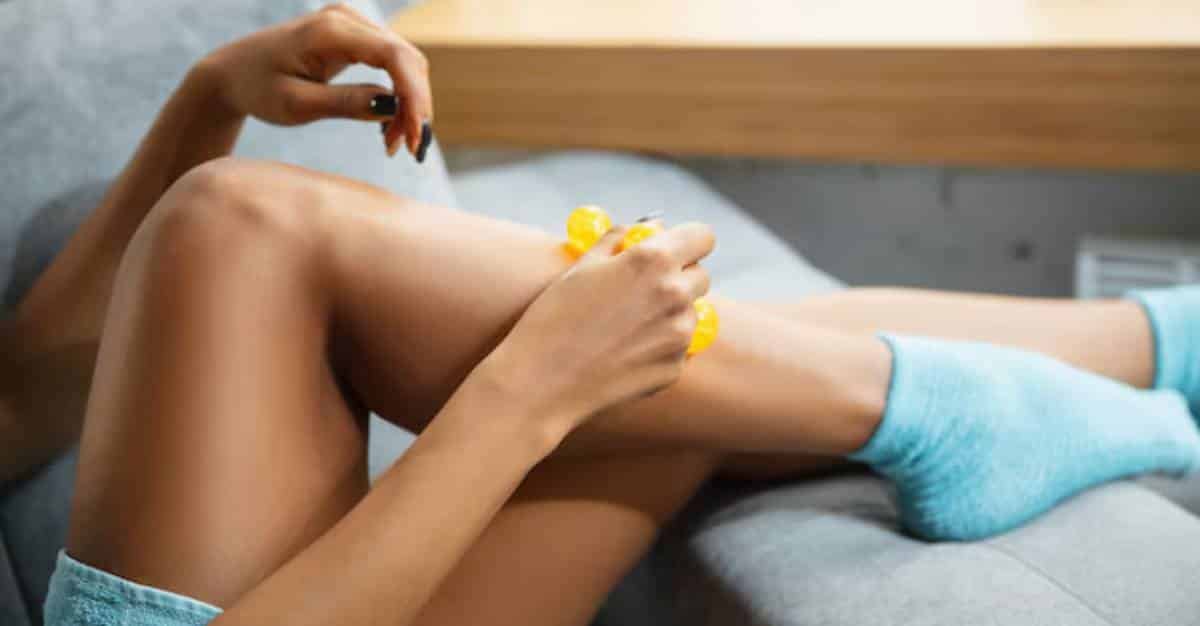
To prepare for a sugaring treatment, it is necessary to ensure that the hair being treated has surpassed the minimum hair length requirement needed for the sugar paste to grasp onto, which is measured to be a few millimeters or one-fourth of an inch long.
If the hair is too short the paste will not be able to adhere properly and the treatment will not achieve the desired results. In addition, do not shave or wax the area weeks before the appointment to allow the hair to reach the required length for the sugaring session.
In relaxing before sugaring, try to eliminate skin-irritating products such as retinoids or exfoliators that can heighten the sensitivity of the skin. These products can put the skin in an irritated state which can worsen the discomfort from the sugaring procedure.
It is best to not use these products for at least 2 days before the appointment to ensure that the skin is ready for sugaring treatment. Whenever possible, healthy and calm skin before the sugaring procedure results in easier and more pleasant experiences with unwanted hair removal.
Sunscreen isn’t just an afterthought in this procedure, it must be applied well before and after the procedure. The sugar paste could feel extra irritating for sunburnt or natural skin irritations and the sugaring process itself could be painful too.
It’s always best to push back the appointment if there are cuts, rashes, and other infections to prevent worse conditions. When skin is clean, sugar paste is less likely to cause adverse side effects while also ensuring swift adhesion to the skin.
Step-By-Step Guide To Sugaring
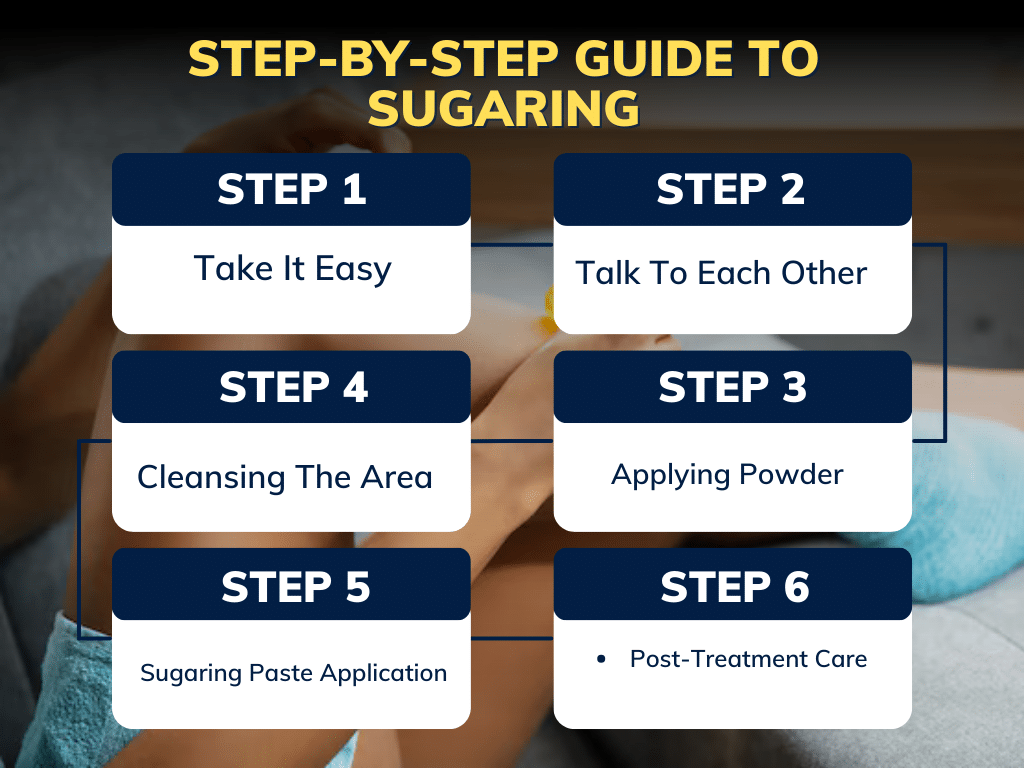
Although sugaring is a very straightforward and easy process, there are things to always bear in mind before your appointment. It’s your technician’s responsibility to guide you through the sugaring appointment so that you’re at ease throughout the procedure. Below, you will find a portrayal of the sugaring process so that you know what to expect at a sugaring appointment.
-
Take It Easy
The first step will be to get you undressed or you can simply pull your skirts up if you are targeting a specific part of the body. Rest assured knowing that your technician is a qualified professional who will make you feel relaxed.
Next, you will settle down on your treatment table in a comfortable position at which point, you will be ready to proceed!
-
Talk To Each Other
As is the case with every hair removal process, communication is essential before the process begins.
If there are certain areas that you are comfortable working on or want the technician to pay attention to and make an effort on, then they need to know. Taking a Brazilian Wax, for instance, one needs to explain the style they wish to have the area designed.
-
Cleansing The Area
The next stage involves cleansing the area for treatment. This step is critical since it ensures the removal of oils, dirt, and additional products that may interfere with the sugaring process.
Clean skin guarantees that the sugar paste attaches to the hair as required, thus providing optimal results.
-
Applying Powder
Your technician will proceed to apply a light dusting of powder to the area. This absorbs moisture helps protect the skin and allows hair to erect, making it easier for the sugar paste to make contact with the hair without causing any irritation to the skin.
-
Sugaring Paste Application
This is the best part! The technician will apply powder in the reverse direction of your hair’s nature. This allows the paste to penetrate the hair follicles. The paste is then removed at the hair growth direction, pulling hair out at the root.
-
Post-Treatment Care
After the sugaring, your technician will then apply either a soothing serum or oil. This aids in moisturizing the skin, calming irritation, and preventing ingrown hairs. You’ll feel smooth, refreshed, and ready to go!
Benefits Of Sugaring For Your Skin

Sugaring goes beyond unwanted hair removal as it helps achieve smooth and healthier skin. If you are in search of an effective and gentle hair removal method that is environmentally pleasant, then sugaring is the definite answer.
Mild Exfoliation For Soft Skin
Sugaring paste is engineered to adhere not only to the hair and sugaring is not limited to hair removal, it is also used to trap dead skin and exfoliate. The sugar paste utilizes gentle sugaring hair removal which removes hair and pulls dead skin cells away with it.
The method increases your skin’s radiance while revealing the more delicate layers of skin. Over time, exfoliation has enormous benefits for your skin. With consistent hair removal using sugar paste, skin stays moisturized and supple.
A glowing appearance is the ultimate goal. On top of that, the natural expulsion of dry skin will help achieve a clearer complexion.
Thinner, Softer Hair Growth
In the same way, sugaring differs from waxing, over time it will lead to hair regrowth that is softer and thinner. This is because Sugaring is done by pulling out the hair from the roots which weakens the hair follicles over time.
This leads to hair growing back finer and slower which reduces the number of sessions required later. Additionally, the hair growth is less conspicuous, so there is no need to worry about the unpleasant prickle during the regrowth phase that accompanies shaving.
Therefore, sugaring does not only assist in making your skin soft but also results in less painful hair removal procedures in the future.
Nutritive Components For Hair Removal
The use of sugar paste for hair sugaring is broadly popular owing to its benefits. Chemically derived ingredients offer a host of threats to those who have delicate skin. This remedy for removing body hair will benefit those who are sensitive to waxes containing chemicals as it poses a minimum risk to the skin.
While some waxing products may contain scent additives and other harmful artificial substances, sachets of golden paste do not put their users at risk. Sugaring is a much better option for anyone tired of allergies or other forms of irritations as pastes are soft and non-abrasive on the skin.
Eco-Friendly And Sustainable
In comparison to waxing, sugaring serves as a more eco-friendly option. Since the sugar paste is water soluble, it is simple to clean up and leaves no sticky mess.
Moreover, it can be reapplied to the same body area during a session, as opposed to wax which is single-use only. This reduction in waste makes sugaring more environmentally friendly for those who care about their eco-friendly practices.
The ease of use and renewability of the ingredients also make sugaring significantly more viable than waxing in the long term. You really can have smooth skin and save the world at the same time!
Less Painful Than Other Methods
All methods of removing hair seem to be uncomfortable in one way or another, but most sugaring users agree that it tends to be less painful than waxing.
Unlike waxing, sugaring uses a sugar paste that only attaches to the hair and dead skin, and not to the live skin, thus reducing irritation. Sugaring has the added benefit of being able to extract hair in the direction in which it grows.
This reduces the chances of broken hair follicles and ingrown hairs. The pain associated with waxing is significantly stronger. With continual sugaring treatment, as the hair becomes finer, the process becomes even less painful.
Easy Cleanup After Treatment
When talking about the benefits of sugaring, one of the points is how effortless it is to clean up. Unlike wax, which sticks and is messy, sugar pastes dissolve with warm water.
Sugaring is very easy because no extra equipment is needed for cleaning and there is no scrubbing involved. A damp cloth will do the trick if the sugar paste ends up on your clothing or skin.
Sugaring is perfect for anyone who wants to remove hair with little to no effort due to the lack of mess made during the procedure.
Is Sugaring Right For You?
As a result of its all-natural components, sugaring is a gentle way of removing hair that works for a variety of skin types. It is particularly effective for sensitive skin. Sugaring, unlike traditional waxing, only attaches itself to hair follicles and dead skin layers, which reduces irritation and makes it a favorable option for delicate skin.
Appropriate Skin Types
Considering the delicate nature of sensitive skin, sugaring is best for its minimal skin irritation and allergic reactions. Sugaring’s protective natural ingredients – sugar, water, and lemon juice – are all hypoallergenic and a much safer option for those highly sensitive.
Factors To Address
In as much as sugaring is considered safe, some conditions would need some level of caution:
- Sunburned or Irritated Skin: Having any sunburned portions of the skin or any other irritated areas should be avoided, as the sugaring process may make things worse.
- Skin Conditions: If you happen to suffer from any form of inflamed eczema, psoriasis, or even skin in general, it is advisable to talk to a dermatologist first.
- Medications: Before going through the sugaring process, one is better off waiting until treatment is completed due to the thinning of the skin from medication like Accutane or topical retinoids.
- Pregnancy: This method is widely accepted for use during pregnancy, however, please check with your doctor to determine if it is right for your case.
Bottom Line
So, as you know how is sugaring done, you can understand that it is an all-natural formula that comprises sugar, water, and lemon juice, which makes it hypoallergenic. Because of this, the chances of skin irritation occurring are far less than with traditional waxing.
For those with skin disorders (such as eczema) or severe cases on medication, it is best to consult a professional before sugaring. In the case approach is done with sensibility, sugaring will prove to be a painless choice for hair removal in the long term.

